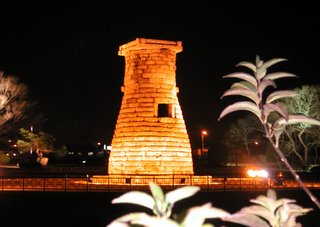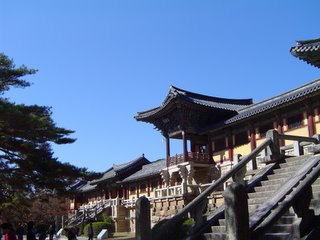I was lucky to visit this place with my fellow school employees shortly after arriving in Korea. Unfortunately, I didn't have a camera to prove I was actually here. So once again, I've "borrowed" some pictures.
Gyeongju was very remarkable & could easily be explored for days. At one time it was the capital of the ancient kingdom of Silla, which ruled from 57 B.C. to 925 A.D.

The picture you see above is borrowed from this site. These mounds are actually tombs, presumed to be those of kings and court officials. The size of the tombs vary with heights ranging from 9 to 75 feet. Some of them are double mounds for the joint burial of a husband and wife. To my knowledge, there are only a few that have been unearthed revealing the treasures inside.
 From the early 1900s to 1970s, Cheomseongdae (above) was considered as an astronomical observatory with some questions regarding its functionality. According to this theory, Cheomseongdae is the oldest surviving observatory in East Asia. Although, there are still many questions debating its purpose. Regardless, this is a great night picture from Unique Tour.
From the early 1900s to 1970s, Cheomseongdae (above) was considered as an astronomical observatory with some questions regarding its functionality. According to this theory, Cheomseongdae is the oldest surviving observatory in East Asia. Although, there are still many questions debating its purpose. Regardless, this is a great night picture from Unique Tour.
I thank Wikipedia for this picture.

The construction of Bulguksa Temple began in 751. It was under the observation of the Silla Chief Minister, Gim Daeseong (701-774), and was completed in 774. It has since been burned during Japanese invasion, but rebuilt to it's present form. Only the stone work has lasted the test of war & is still original. I thank Mandalynn Champany for this photo.
 Constructed around the same time, Seokguram is a man-made cave carved from white granite. On the walls surrounding Buddha are 38 other Bodhisattvas, disciples, Dharma-protectors, and the Four Heavenly Kings. This stone grotto is one of Korea's greatest masterpieces. I thank http://www.korea.net/korea/kor_loca.asp?code=G0602 for it's information & photo.
Constructed around the same time, Seokguram is a man-made cave carved from white granite. On the walls surrounding Buddha are 38 other Bodhisattvas, disciples, Dharma-protectors, and the Four Heavenly Kings. This stone grotto is one of Korea's greatest masterpieces. I thank http://www.korea.net/korea/kor_loca.asp?code=G0602 for it's information & photo.
This is a photo of Seokguram from outside the interior walls. One of the reasons this picture is "borrowed" is because we're asked not to take pictures inside. Seokguram is apparently world famous & has been designated National Treasure No. 24. In December 1995, together with Bulguksa, they were added to the UNESCO World Heritage list. Thanks for the picture & all the info.


